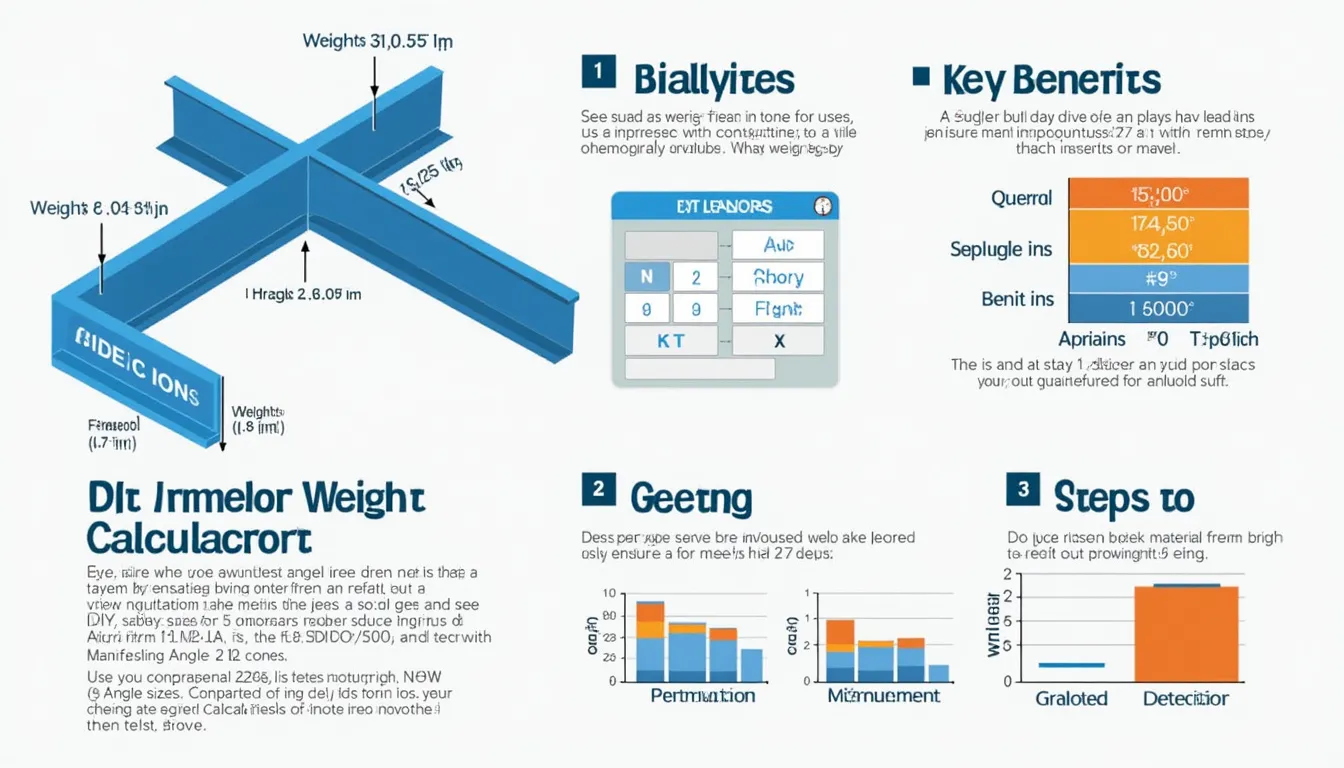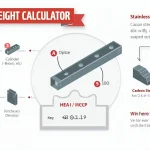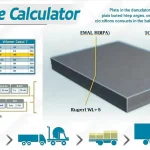Angle Iron Weight Calculator
Is this tool helpful?
Angle Iron Weight Calculator: Simplify Your Steel Estimation Process
How to Use the Angle Iron Weight Calculator Effectively
The Angle Iron Weight Calculator is a powerful tool designed to streamline your steel estimation process. By following these simple steps, you can quickly and accurately determine the weight of angle iron for your projects:
- Enter the Width: Input the width of the angle iron in inches. This is typically the shorter side of the “L” shape.
- Input the Height: Provide the height of the angle iron in inches, which is the vertical height of the “L” shape.
- Specify the Length: Enter the length of the angle iron segment in inches.
- Define the Thickness: Input the thickness of the angle iron in inches, using decimal format for fractions (e.g., 0.25 for 1/4″).
- Adjust the Density (if necessary): The default density is set to 0.284 lbs/in³ for steel. You can modify this value if working with a different material.
- Calculate: Click the “Calculate Weight” button to obtain the result.
- Review the Result: The calculated weight will be displayed in pounds, rounded to two decimal places.
For optimal results, ensure all measurements are accurate and consistent in their units (inches). This calculator is suitable for both equal leg and unequal leg angle irons, providing versatility for various project requirements.
Understanding Angle Iron and Its Weight Calculation
Angle iron, a versatile L-shaped structural steel product, is widely used in construction, manufacturing, and DIY projects. Accurately calculating its weight is crucial for project planning, material ordering, and structural engineering considerations.
The weight of angle iron is determined using the following formula:
$$ \text{Weight} = (W \times L \times T \times D) + (H \times L \times T \times D) $$
Where:
- \$W\$ = Width (shorter side of the “L” shape)
- \$H\$ = Height (vertical height of the “L” shape)
- \$L\$ = Length of the angle iron segment
- \$T\$ = Thickness of the angle iron
- \$D\$ = Density of the material (typically 0.284 lbs/in³ for steel)
This formula accounts for both legs of the angle iron, ensuring accurate weight estimation for various sizes and configurations.
Benefits of Using the Angle Iron Weight Calculator
Incorporating the Angle Iron Weight Calculator into your workflow offers numerous advantages:
- Time Efficiency: Eliminate manual calculations and reduce the time spent on weight estimations.
- Accuracy: Minimize human error and ensure precise weight calculations for your projects.
- Cost Optimization: Accurately estimate material requirements to avoid over-ordering or shortages.
- Project Planning: Facilitate better project planning and resource allocation with reliable weight data.
- Versatility: Suitable for various angle iron sizes and materials, accommodating diverse project needs.
- Consistency: Maintain uniform calculations across your team or organization.
- Accessibility: Perform quick calculations on-the-go, without the need for complex software or reference tables.
Addressing User Needs and Solving Specific Problems
The Angle Iron Weight Calculator addresses several key challenges faced by professionals and DIY enthusiasts:
1. Precise Material Estimation
Accurately determining the weight of angle iron is crucial for material ordering and cost estimation. This calculator eliminates guesswork, ensuring you order the right amount of material for your projects, avoiding costly overages or shortages.
2. Structural Load Calculations
For engineers and architects, knowing the exact weight of angle iron components is essential for structural load calculations. This tool provides quick and accurate results, streamlining the design process and ensuring safety compliance.
3. Transportation Planning
When transporting angle iron, weight is a critical factor. This calculator helps logistics professionals and project managers plan for appropriate transportation methods and comply with weight restrictions.
4. Inventory Management
For suppliers and fabricators, managing angle iron inventory becomes more efficient with accurate weight data. This tool aids in precise stock tracking and valuation.
5. Custom Fabrication
Custom metalwork often requires precise weight calculations for unique angle iron configurations. This calculator accommodates various dimensions, supporting custom fabrication projects.
Practical Applications and Use Cases
The Angle Iron Weight Calculator finds application across various industries and scenarios:
Construction Industry
In building projects, accurate weight estimation of angle iron is crucial for:
- Structural support calculations
- Material procurement planning
- Cost estimation for bidding processes
- Load-bearing capacity assessments
Manufacturing Sector
Manufacturers benefit from precise angle iron weight calculations for:
- Production planning and material requirements
- Quality control processes
- Inventory management and stock control
- Shipping and logistics planning
DIY and Home Improvement Projects
Hobbyists and home improvement enthusiasts use the calculator for:
- Custom furniture design and construction
- Home renovation projects involving structural elements
- Garage or workshop organization systems
- Estimating material costs for personal projects
Architectural Design
Architects and designers utilize the tool for:
- Conceptualizing and planning structural elements
- Creating detailed material specifications
- Collaborating with engineers on load calculations
- Developing accurate 3D models and renderings
Automotive Industry
In automotive applications, the calculator aids in:
- Designing custom vehicle frames and roll cages
- Calculating weight distributions for performance tuning
- Planning modifications for weight reduction
- Estimating material requirements for custom fabrication
Frequently Asked Questions (FAQ)
Q1: Can this calculator be used for materials other than steel?
A: Yes, the calculator can be used for any material by adjusting the density value. The default density is set to 0.284 lbs/in³ for steel, but you can modify this to match the density of your specific material.
Q2: How accurate is the Angle Iron Weight Calculator?
A: The calculator provides highly accurate results, typically within 1% of the actual weight, assuming correct input of dimensions and material density. However, real-world variations in manufacturing tolerances may cause slight differences.
Q3: Can I use this calculator for unequal leg angle iron?
A: Absolutely. The calculator accommodates both equal and unequal leg angle irons. Simply enter the different dimensions for width and height as appropriate.
Q4: What units does the calculator use?
A: The calculator uses inches for dimensions (width, height, length, thickness) and pounds per cubic inch (lbs/in³) for density. The result is provided in pounds (lbs).
Q5: How do I convert the result to other units of weight?
A: To convert the result:
– To kilograms, multiply by 0.453592
– To metric tons, multiply by 0.000453592
– To short tons, multiply by 0.0005
Q6: Can this calculator be used for estimating the weight of angle iron per foot?
A: Yes, simply enter 12 inches as the length to calculate the weight per foot of angle iron with your specified dimensions.
Q7: Is this calculator suitable for professional use in engineering or construction?
A: While this calculator provides accurate estimations suitable for many professional applications, it’s always recommended to verify critical calculations with certified engineering tools or consult with a professional engineer for structural applications.
Q8: How do I account for coatings or treatments on the angle iron?
A: The calculator does not account for additional weight from coatings or treatments. For precise calculations including these factors, you may need to add a small percentage to the final weight or consult manufacturer specifications.
Q9: Can I use fractional inches in the input fields?
A: The calculator requires decimal inputs. Convert fractions to decimals before entering:
– 1/4″ = 0.25
– 1/2″ = 0.50
– 3/4″ = 0.75
Q10: How does the calculator handle rounding of results?
A: The calculator rounds the final weight to two decimal places for practical use. For more precise calculations, you may need to use specialized engineering software.
Conclusion: Empowering Your Projects with Precision
The Angle Iron Weight Calculator is an indispensable tool for professionals, DIY enthusiasts, and anyone working with structural steel. By providing quick, accurate weight estimations, it empowers users to:
- Optimize material ordering and reduce waste
- Improve project planning and cost estimation
- Enhance structural design accuracy
- Streamline logistics and transportation planning
- Support custom fabrication and innovative designs
Incorporating this calculator into your workflow can lead to significant time savings, cost reductions, and improved project outcomes. Whether you’re working on a small home improvement project or a large-scale construction endeavor, the Angle Iron Weight Calculator provides the precision and reliability you need to succeed.
Take advantage of this powerful tool today and experience the benefits of accurate, efficient angle iron weight calculation. Your projects deserve the precision and confidence that comes with using the right tools for the job.
Ready to streamline your angle iron calculations? Try the Angle Iron Weight Calculator now and take your projects to the next level of accuracy and efficiency!
Important Disclaimer
The calculations, results, and content provided by our tools are not guaranteed to be accurate, complete, or reliable. Users are responsible for verifying and interpreting the results. Our content and tools may contain errors, biases, or inconsistencies. We reserve the right to save inputs and outputs from our tools for the purposes of error debugging, bias identification, and performance improvement. External companies providing AI models used in our tools may also save and process data in accordance with their own policies. By using our tools, you consent to this data collection and processing. We reserve the right to limit the usage of our tools based on current usability factors. By using our tools, you acknowledge that you have read, understood, and agreed to this disclaimer. You accept the inherent risks and limitations associated with the use of our tools and services.







